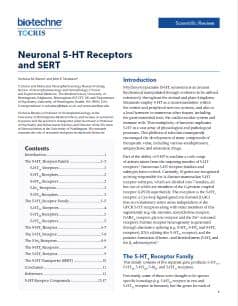5-HT6 Receptors
Serotonin 5-HT6 receptors are located primarily in the striatum, olfactory tubercles, nucleus accumbens and hippocampus. Functions of 5-HT6 receptors include modulation of cholinergic and dopaminergic neurotransmission, and a role in spatial learning and memory.
5-HT6 Receptor Agonists |
|
|---|---|
| Cat. No. | Product Name / Activity |
| 2382 | EMD 386088 hydrochloride |
| Potent 5-HT6 agonist | |
| 5589 | WAY 181187 oxalate |
| High affinity and selective 5-HT6 agonist | |
| 3904 | WAY 208466 dihydrochloride |
| Selective 5-HT6 agonist | |
5-HT6 Receptor Antagonists |
|
| Cat. No. | Product Name / Activity |
| 3326 | BGC 20-761 |
| High affinity 5-HT6 antagonist | |
| 6748 | PRX 07034 |
| Potent and selective 5-HT6 antagonist | |
| 1961 | SB 258585 hydrochloride |
| Potent, selective 5-HT6 antagonist | |
| 3368 | SB 271046 hydrochloride |
| Selective 5-HT6 antagonist; orally active | |
| 3189 | SB 399885 hydrochloride |
| Potent and selective 5-HT6 antagonist | |
Serotonin 5-HT6 receptors are located primarily in the striatum, olfactory tubercles, nucleus accumbens and hippocampus. Functions of 5-HT6 receptors include modulation of cholinergic and dopaminergic neurotransmission, and they have a role in spatial learning and memory. The human 5-HT6 receptor gene has been localized to chromosome 1 (1p35-36).
External sources of pharmacological information for 5-HT6 Receptors :
Literature for 5-HT6 Receptors
Tocris offers the following scientific literature for 5-HT6 Receptors to showcase our products. We invite you to request* your copy today!
*Please note that Tocris will only send literature to established scientific business / institute addresses.
5-HT Receptors Scientific Review
Written by Nicholas M. Barnes and John F. Neumaier, this review summarizes the various serotonin receptor subtypes and their importance in mediating the role of serotonin in numerous physiological and pharmacological processes. Compounds available from Tocris are listed.

